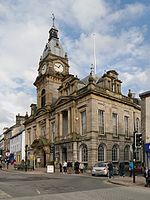Kendal

Kendal, once Kirkby in Kendal or Kirkby Kendal, is a market town and civil parish in the Westmorland and Furness district of Cumbria, England. It lies within the River Kent's dale, from which its name is derived, just outside the boundary of the Lake District National Park. In the Domesday Book of 1086, the area was collected under Yorkshire. The area came under the Honour of Lancaster before the barony split. The town became the Barony of Kendal's seat, in 1226/7 this barony merged with the Barony of Westmorland to form the historic county of Westmorland with Appleby as the historic county town. From 1889–1974, it became the county town. Under the 1974 reforms, it became the administrative centre of the South Lakeland district. The town became Westmorland and Furness district's administrative centre in a 2023 reform. It is 8 miles (13 km) south-east of Windermere and 19 miles (31 km) north of Lancaster. At the 2011 Census, the town had a population of 28,586, making it the second largest town in Westmorland and Furness after Barrow-in-Furness. As of the 2021 Census, its population was 29,593. It is renowned today mainly as a centre for shopping, for its festivals and historic sights, including Kendal Castle, and as the home of Kendal Mint Cake. The town's grey limestone buildings have earned it the sobriquet "Auld Grey Town".
Excerpt from the Wikipedia article Kendal (License: CC BY-SA 3.0, Authors, Images).Kendal
Kent Place,
Geographical coordinates (GPS) Address Nearby Places Show on map
Geographical coordinates (GPS)
| Latitude | Longitude |
|---|---|
| N 54.326 ° | E -2.745 ° |
Address
Kent Place
Kent Place
LA9 4DZ , Kirkbarrow
England, United Kingdom
Open on Google Maps










